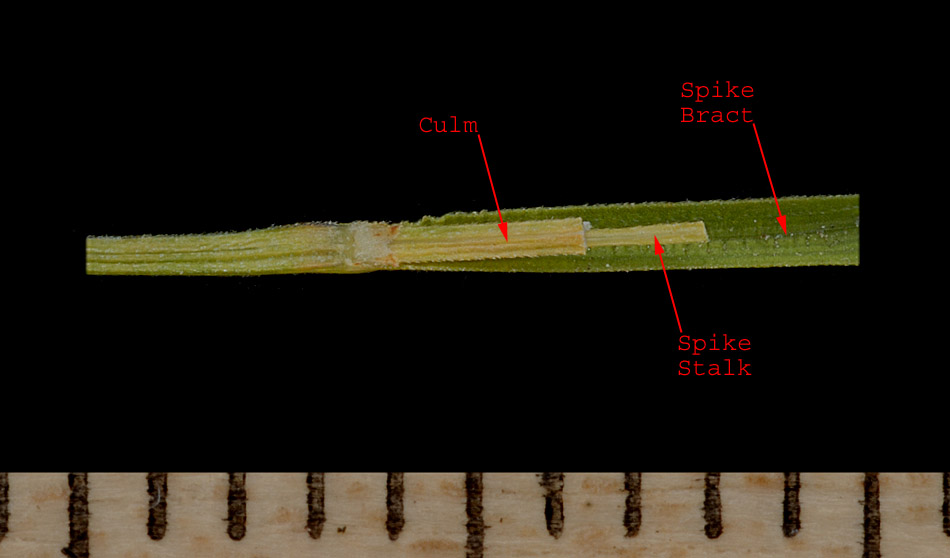 | Rossii:
Answers to key questions in Sedges (Carex) of Saskatchewan, Fascicle 3,
Flora of Saskatchewan by Anna Leighton leading to this species. The
answers are in the order you would normally work through the key.
 | Stigmas 3; achenes three-sided,
occasionally terete, though their shape may be concealed by flattened
perigynia. NOT [Stigmas 2; achenes lenticular.] |
 | Spikes 2 or more per culm, terminal
and lateral; spike bracts present on lateral spikes (except in Section Phyllostachyae),
lowest bract usually evident, often conspicuous. NOT [Spikes 1 per culm, terminal; spikes bracts absent.] |
 | Lower pistillate scales not
bract-like or leaf-like but similar in size and shape to individual
perigynia (up to twice as long as perigynia in C. magellanica
ssp. irrigua). NOT [Lower pistillate scales resembling
green, leaf-like bracts much longer and wider than individual perigynia.
Section Phyllostachyae. (C. backii, C.
saximontana)] |
 | Perigynia sparsely to densely
pubescent or puberulent (in C. pedunculata pubescence represented
by very short hairs scattered near tip; in some species of Sect. Acrocystis,
perigynia may be glabrous or virtually hairless, but all members of this
section have convexly 3-sided to terete achenes with tight-fitting
perigynia and a stipe-like base about equal to beak in length).
NOT [Perigynia glabrous (i.e. lacking a pubescence).] |
 | Perigynia usually less than 5 mm
long but if longer, beak distinctly shorter than perigynium body;
pubescence various. NOT [Perigynia 5-7 mm long with beak as long as or
longer than perigynium body; pubescence on the perigynia dense, stiff
and pointing toward tip.] |
 | Achenes convexly 3-sided to terete;
perigynia tightly enclosing achenes and convexly 3-sided to terete,
sparsely pubescent, (rarely glabrous in C. deflexa and C.
rossii, pubescent only on ribs in C. tonsa); stipe-like base
about equal to beak in length; pistillate spike bracts sheathless.
Section Acrocystis. (C. deflexa, C. inops
ssp. heliophila, C. peckii, C. rossii, C. tonsa,
C. umbellata.) NOT
[Achenes with +/- flat sides; perigynia loosely fitting achene and
variously shaped in cross-section, densely to sparsely pubescent
(faintly puberulent with very short hairs scattered near tip in C.
pedunculata); pistillate spike bracts sheathing or sheathless.] |
 | Some or all pistillate spikes basal,
i.e. attached near base of plant and borne among leaf bases. NOT [All
pistillate spikes cauline, i.e. attached near top of regular, elongate
culms and born at or above level of leaf tips.] |
 | Pistillate scales (excluding awn)
usually shorter than perigynia; beak straight or bent; basal spikes few.
NOT [Pistillate scales as long as, or longer than, perigynia;
beak straight; basal spikes more numerous than cauline spikes.] |
 | Staminate spike 4-10 (12.8) mm long
with stalks 1-10 mm long, usually visible above pistillate spikes;
lowest cauline pistillate spike bract leaf-like, to 7 cm long, usually
distinctly longer than inflorescence; perigynia 3 mm long or a little
longer with beak 0.8-1.5 mm long. NOT
[Staminate spike 3-5 (5.7) mm long, often hidden by adjacent pistillate
spikes; lowest cauline pistillate spike bract leaf-like or bristle-like,
0.7-3 cm long, as long as, or overtopping, inflorescence; perigynia up
to 2.5 (3.1) mm long with beak 0.4-0.8 mm long.] |
|

